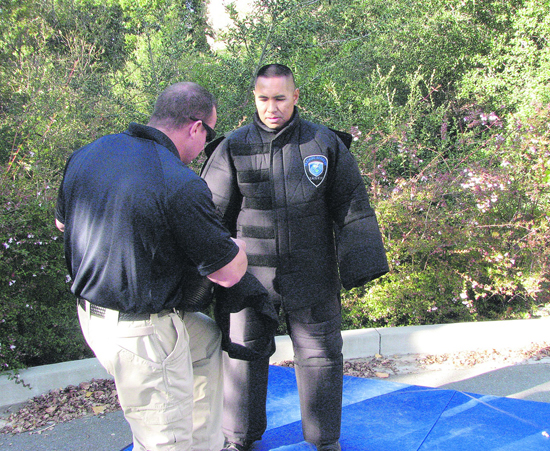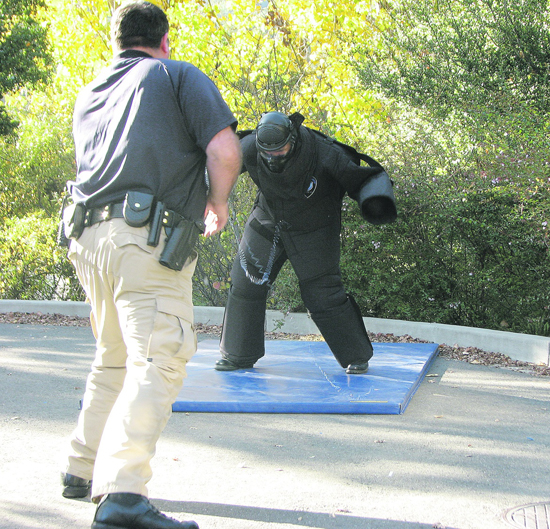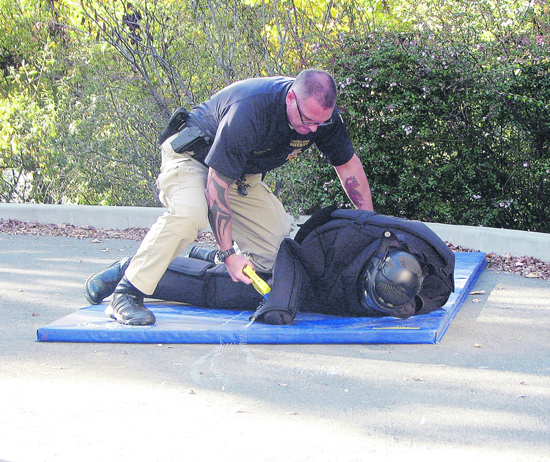 | | | Detective Sergeant Neil Rafanan (in padded suit) talks with Shawn Murray during recent training of the Orinda Police Department in Taser use.
Photos courtesy of the Orinda Police Department.
| | | | | | A Taser in the wrong hands can cause a media sensation. The Orinda Police Department believes that in the right hands the oft maligned weapon makes life safer for the men and women who run toward rather than away from danger, as well as for the citizens they protect.
 All fourteen members of Orinda's Police Department (OPD) are being trained as part of a larger program by the Contra Costa Sheriff's Department (CCSD), which also staffs the Lafayette Police Department, to teach its officers to use the Taser X-26, an Electronic Control Device (ECD). Officers in the Moraga Police Department have carried Tasers for several years.
All fourteen members of Orinda's Police Department (OPD) are being trained as part of a larger program by the Contra Costa Sheriff's Department (CCSD), which also staffs the Lafayette Police Department, to teach its officers to use the Taser X-26, an Electronic Control Device (ECD). Officers in the Moraga Police Department have carried Tasers for several years.
 "Every officer who is on duty will be carrying a Taser," likely beginning in January 2012, says Detective Sergeant Neil Rafanan, a CCSD detective assigned to the OPD. Orinda's Tasers will be bright yellow to ensure that nobody mistakes a gun for a Taser.
"Every officer who is on duty will be carrying a Taser," likely beginning in January 2012, says Detective Sergeant Neil Rafanan, a CCSD detective assigned to the OPD. Orinda's Tasers will be bright yellow to ensure that nobody mistakes a gun for a Taser.
 "The Sheriff's Department has been thinking about this since Warren Rupf's time," Rafanan explains. Rupf was the Sheriff from 1992 until his retirement last January. Rafanan, who puts criminals away for OPD's Investigations unit, is playing a key role in training Orinda's police to use their new weapons safely and judiciously-he has been a trainer since the end of 1998 and an instructor at the police academy since 2003.
"The Sheriff's Department has been thinking about this since Warren Rupf's time," Rafanan explains. Rupf was the Sheriff from 1992 until his retirement last January. Rafanan, who puts criminals away for OPD's Investigations unit, is playing a key role in training Orinda's police to use their new weapons safely and judiciously-he has been a trainer since the end of 1998 and an instructor at the police academy since 2003.
 Rafanan believes the ECDs are safer for the police - and for the general public. "For every (gun) shot that you send down range, potentially another one will be returned," he says.
Rafanan believes the ECDs are safer for the police - and for the general public. "For every (gun) shot that you send down range, potentially another one will be returned," he says.
 Tasing lasts roughly five seconds under CCSD policy, which also specifies that ECDs may only be deployed in an immediate threat to an officer or another person. When asked about a San Francisco Chronicle article likening ECDs to cardiologists shocking hearts, Rafanan replies, "It's a much weaker charge." Compared with a wall socket's 16 amperes and the 1 amp of a Christmas tree bulb, the ECD is only .0036 ampere. Officers are trained not to aim for the heart.
Tasing lasts roughly five seconds under CCSD policy, which also specifies that ECDs may only be deployed in an immediate threat to an officer or another person. When asked about a San Francisco Chronicle article likening ECDs to cardiologists shocking hearts, Rafanan replies, "It's a much weaker charge." Compared with a wall socket's 16 amperes and the 1 amp of a Christmas tree bulb, the ECD is only .0036 ampere. Officers are trained not to aim for the heart.
 "It's not comfortable," Rafanan says of his own tasing during training, "but it's not fatal." California, he states, "is considered the pinnacle of police training in the country."
"It's not comfortable," Rafanan says of his own tasing during training, "but it's not fatal." California, he states, "is considered the pinnacle of police training in the country."
 Not counting supplemental instruction, Orinda's officers each complete at least 24 hours of professional development each year, involving legal and skills instruction on handling active shooters, accident and DUI interviews and investigations, automobile operation, and the latest in life saving. In addition to knowing First Aid and CPR, members of the OPD are able to use AEDs (Automated External Defibrillators).
Not counting supplemental instruction, Orinda's officers each complete at least 24 hours of professional development each year, involving legal and skills instruction on handling active shooters, accident and DUI interviews and investigations, automobile operation, and the latest in life saving. In addition to knowing First Aid and CPR, members of the OPD are able to use AEDs (Automated External Defibrillators).

|


